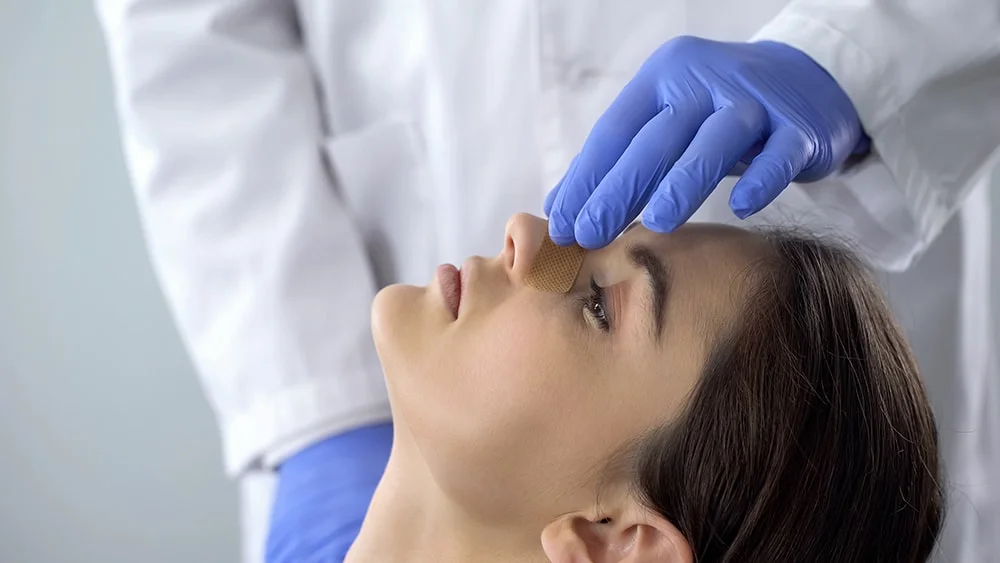Blepharoplasty
A common occurrence of aging begins to show when the delicate skin around the eyes starts to sag, wrinkle, puff, or stretch — sometimes creating an involuntary look of being tired or stressed. Other symptoms can be puffiness from excess skin and fat, or a “hooding” effect from overhanging eyelid skin that may even have an effect on one’s field of vision. Blepharoplasty — a highly effective eyelid enhancing procedure — helps to reduce these cosmetic concerns by lifting and contouring the skin and fat around the upper and/or lower eyelids to restore a more youthful appearance.
Quick Facts About Blepharoplasty
- Procedure:
- Approximately 1-2 hours
- Anesthesia:
- Local or general anesthesia
- Recovery:
- About 5-10 days (for office jobs and non-strenuous activities)
- Post-op Visits:
- 1 day, 1 week, 3 weeks, 6 weeks, 6 months
- Cost:
- Starts at $5,000
Customizing a Blepharoplasty Surgical Plan
Fellowship-trained in New York City by pioneers of facial rejuvenation surgery, Dr. Kurkjian is uniquely experienced in developing and performing personalized blepharoplasty procedural plans using the most advanced and effective techniques available.
During your personal consultation with Dr. Kurkjian, he will perform a complete cosmetic evaluation of your face and eyes to determine what enhancements can be made to address your concerns and achieve the look you desire. This may involve excising extra eyelid skin, removing or relocating fat, and even tightening or repositioning muscles around the eyes. In the event you want a more comprehensive facial rejuvenation—or if Dr. Kurkjian believes eyelid surgery alone will not create the best, most natural-looking result—he might recommend combining treatment with one or more complementary procedures, such as brow lift surgery, fat transfer, facelift surgery, chemical peels, or injectables.
Once you and Dr. Kurkjian have agreed upon a plan for surgery, he will discuss the type of anesthesia used, how the procedure will be performed, and any possible risks involved. He will also provide a comprehensive overview of how to prepare for treatment and what to expect during the recovery process. Throughout this conversation, he encourages any and all questions to be asked and/or concerns to be voiced, and he will happily take time to address each one until you feel completely knowledgeable and comfortable about all aspects of care.
If at this point you are ready to move forward with blepharoplasty, a friendly member of our staff will help you schedule a time and date of surgery that works for you, and payment options—including plastic surgery financing—can be discussed in full detail. Ultimately, Dr. Kurkjian and our team want your blepharoplasty experience to be as enjoyable and free of stress as possible, and we will do everything in our control to deliver an exceptional level of care.
What Are the Top Benefits of Eyelid Surgery?
Depending on your specific signs of aging and cosmetic concerns, eyelid surgery can address conditions such as:
- Tired appearance to the eyes
- Puffiness in the upper eyelids
- Loose and/or sagging skin
- Fine wrinkles on the lower eyelids
- Bags under the eyes
- Lower eyelid droopiness
Along with treating these aesthetic issues, eyelid surgery can also be beneficial from a functional standpoint in the event you have significant upper eyelid drooping (ptosis). When this is the case, skin removal and tightening during upper blepharoplasty can lead to a greater range of vision that was previously obstructed by hanging tissue.
How Is the Blepharoplasty Procedure Performed?
At our practice, upper blepharoplasty by itself can often be performed using only local anesthetic and a mild sedative pill for relaxation—reducing both the cost of treatment and recovery time afterwards. For lower blepharoplasty, or when both upper and lower blepharoplasty are combined, general anesthesia is usually necessary.
To perform the upper blepharoplasty procedure, Dr. Kurkjian will first make a small incision in a natural crease of the upper lid, helping to disguise any visible surgical markings. Next, he will meticulously remove extra skin and excise and/or redistribute fat throughout the eyelid, making certain not to overcorrect any concerns in order to avoid creating an unnatural look. If necessary, he may also tighten or repair loose or detached upper eyelid musculature to restore proper positioning. Finally, he will carefully smooth the skin and close the incision via tiny sutures.
For lower blepharoplasty, Dr. Kurkjian can utilize an incision made on the inside of the eyelid (transconjunctival) or on the outside of the lower lid hidden just beneath the lash line. The transconjunctival method is usually reserved for those who have little to no skin or muscle laxity, and the exterior approach is typically best for individuals who have lax, excess skin and loose musculature. Once the chosen incision is made, Dr. Kurkjian will precisely remove and/or redistribute fatty tissue throughout the lower eyelid to achieve an optimal aesthetic. If redundant skin and muscle laxity are present, he will also meticulously excise a small amount of skin (which can also eliminate fine wrinkles) and tighten muscles and tendons. Lastly, Dr. Kurkjian will smooth the remaining skin and suture the incision line closed.
When upper and lower blepharoplasty are performed together, the total treatment time is typically about two hours. Performed separately, each procedure can often be completed in one to one and a half hours , depending on the complexity of the case.
What Is Recovery from Eyelid Lift Surgery Like?
Initially following blepharoplasty, some degree of swelling and bruising may be experienced, but these symptoms are temporary and should resolve with time. Dr. Kurkjian prescribes medication drops, cold compresses, and ointment to enhance healing and provide relief from any discomfort that may be encountered—though most patients report only feeling soreness and/or tenderness as opposed to notable pain. After about five to ten days, most normal, non-strenuous daily routines can generally be resumed, but vigorous exercise, physical sports, and/or other strenuous activities will need to be avoided for approximately two to three weeks.
Throughout the recovery process, Dr. Kurkjian will use a number of follow-up appointments to monitor healing and ensure the results are progressing as predicted. Our team is available to answer all questions and address any concerns you might have—and we will always go above and beyond to make sure your plastic surgery experience is as smooth and stress-free as possible.
Will I Have Scars After Eyelid Surgery?
Visible scarring after blepharoplasty is uncommon, particularly in upper eyelid surgery, as the incisions are typically made in an inconspicuous area of the crease. The chance of noticeable scarring is slightly greater in a lower eyelid surgery, as the incisions are made under the eyelid or around the lash. In any case, scarring after blepharoplasty is usually insignificant, and any scars that do arise typically fade quickly.
How Long Does Blepharoplasty Last?
Depending on the particular area around the eye, blepharoplasty can last anywhere between 10 years to a lifetime. Generally, lower eyelid surgery results are more permanent than upper, often displaying permanent results, whereas upper typically needs to be repeated after 10-20 years. The longevity of results will depend on the patient and specifics of the surgery.
Is a Non-Surgical Blepharoplasty Possible?
We offer a few injectables, such as BOTOX® Cosmetic, that can be administered around the eyes to manage dynamic wrinkles, such as crow’s feet. They can also rejuvenate skin areas like frown lines between the eyebrows and forehead creases to create an overall more refreshed appearance. Please note, however, that they cannot directly tighten the eyelids, as blepharoplasty does, but rather smooth the surrounding skin.
Additional Blepharoplasty Frequently Asked Questions
Will Eyelid Surgery Improve My Vision?
If your field of vision is obstructed by loose skin hanging over your eyes, the lifting effect of upper eyelid surgery may be able to provide an improvement. However, if you are experiencing other sight or vision concerns, it is best to schedule an exam with your eye doctor to determine the cause.
How Does Blepharoplasty Differ from Ptosis Repair?
Typically, blepharoplasty procedures are designed to improve the cosmetic concerns of droopy, excess skin and puffiness around the eyelids. This treatment can help to reverse aesthetic issues of looking tired or advanced in age by creating a more bright-eyed appearance. Alternatively, ptosis repair addresses a medical issue in which the muscles that lift your upper eyelids become too stretched or weakened to fully open your eyes. To repair this eyelid function, it is usually recommended to seek ptosis repair treatment from an oculoplastic surgeon.
How Can I Reduce Swelling After Eyelid Surgery?
To help reduce swelling following eyelid surgery, it is recommended to gently apply cold compresses for the first 24-48 hours, and keep your head elevated during rest. It is normal to experience swelling and symptoms usually diminish within 7-10 days.
When Can I Wear Contacts After Eyelid Surgery?
The eye and eyelid areas should be treated delicately during the healing process and activities that require touching those areas should be avoided to prevent injury and/or infection. This includes the use of contact lenses, in which those patients should only wear eyeglasses as advised by their surgeon. The general restricted time frame is at least two weeks; however, your surgeon will provide further details during follow up evaluations.
When Can I Wear Eye Makeup After Blepharoplasty?
It is strongly recommended to refrain from applying makeup on or near the eye area for two to three weeks following eyelid surgery. The treatment area is sensitive during the recovery process and doing so may cause discomfort or disruption to the incision sites as they heal, and potentially lead to an infection.
Contact Our Practice
For more information about eyelid surgery, or if you wish to schedule a consultation with Dr. Kurkjian, please feel free to contact us today.








